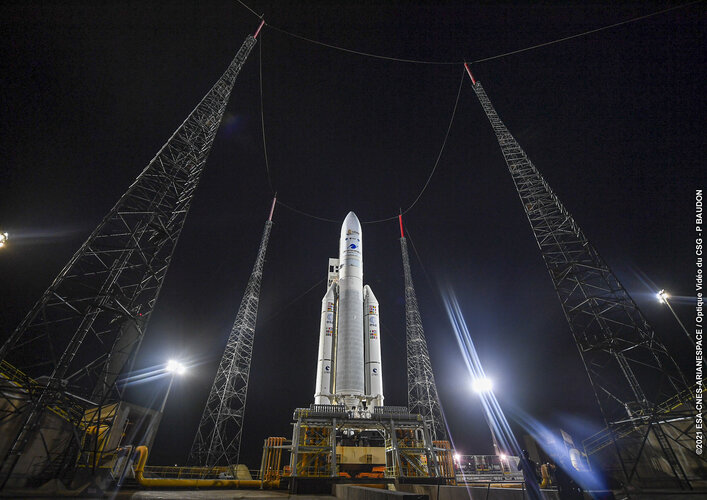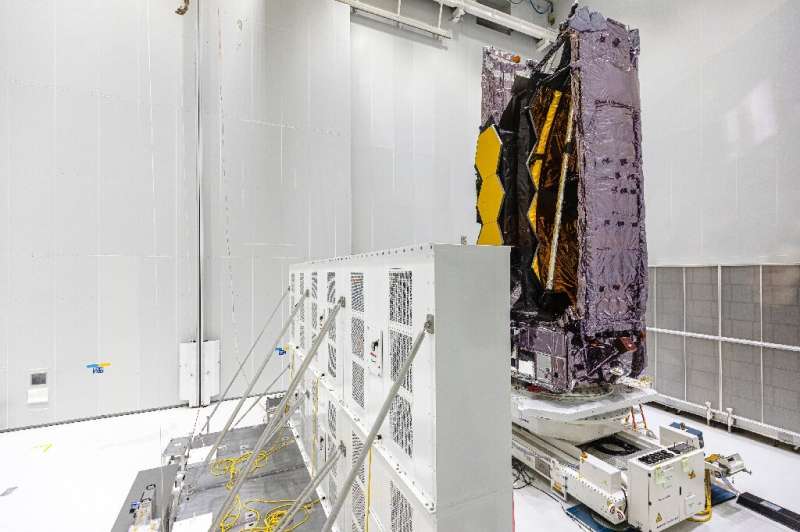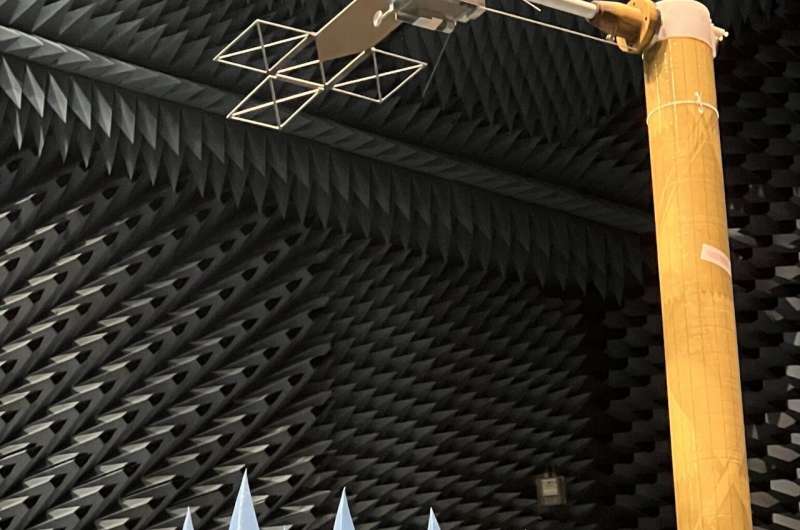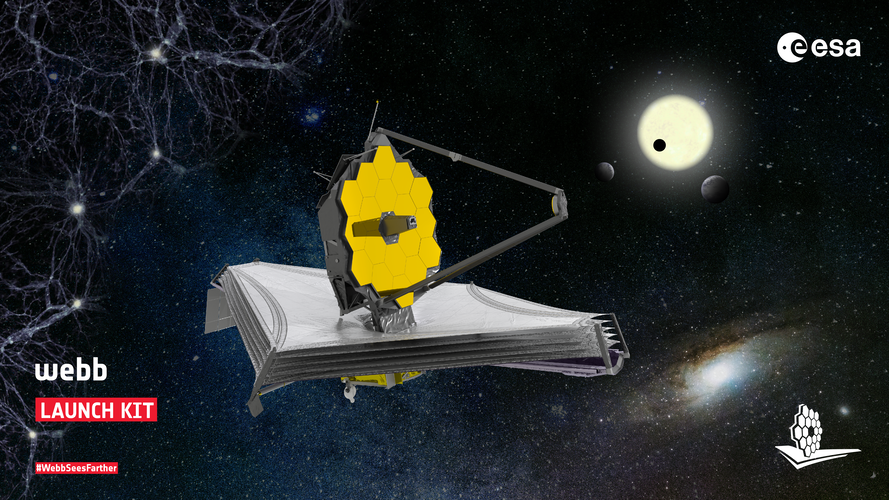
Copernical Team
World's most powerful telescope blasts off into space
 The world's most powerful space telescope on Saturday blasted off into orbit, headed to an outpost 1.5 million kilometres (930,000 miles) from Earth. The James Webb Space Telescope left Earth enclosed in its Ariane 5 rocket from the Kourou Space Centre in French Guiana at 1220 GMT, according to an AFP journalist on the scene.
The world's most powerful space telescope on Saturday blasted off into orbit, headed to an outpost 1.5 million kilometres (930,000 miles) from Earth. The James Webb Space Telescope left Earth enclosed in its Ariane 5 rocket from the Kourou Space Centre in French Guiana at 1220 GMT, according to an AFP journalist on the scene. Red velvet Mars
 Image:
Red velvet Mars
Image:
Red velvet Mars Webb on Ariane 5 poised for launch
 Image:
Image:
The James Webb Space Telescope is safely stowed inside the fairing of ESA’s Ariane 5 launch vehicle, which is now on the launch pad undergoing final checks and fuelling for a targeted liftoff at 12:20 GMT / 13:20 CET on 25 December from Europe's Spaceport in French Guiana.
Webb will be the largest, most powerful telescope ever launched into space. As part of an international collaboration agreement, ESA is providing the telescope’s launch service using the Ariane 5 launch vehicle. Working with partners, ESA was responsible for the development and qualification of Ariane 5 adaptations for the Webb mission and
French Guiana awaits historic Webb telescope launch

Like kids dreaming of presents under the tree, the scientists at the Jupiter control room at the Guiana Space Centre in Kourou are patiently waiting for December 25.
The James Webb Space Telescope—soon to become the most powerful ever to be launched into space—after technical and weather delays is set to take off on Christmas Day from the base in France's South American department.
"We can't wait for it to launch," says Jean-Luc Mestre, engineer and vice-director of operations at the French National Centre for Space Studies (CNES).
This rocket's payload, the Webb telescope, is a piece of technology worked on by thousands of people for over a quarter of a century.
"Everything is ready," Mestre adds. "Now all we need is the right weather."
For days heavy winds and rain have lashed the dense tropical forest surrounding the base, though you'd never know it from inside the vault-like control room, its windowless walls dominated by a bank of glowing screens.
EXPLAINER: Veteran Hubble vs. new Webb space telescope

Don't ask astronomers to choose between the Hubble Space Telescope and the new kid on the cosmic block, the James Webb Space Telescope.
Webb on Ariane 5 roll-out to the launch pad

On Thursday 23 December, the James Webb Space Telescope, safely stowed inside the fairing of ESA’s Ariane 5 launch vehicle, left the final assembly building for roll-out to the launch pad at Europe’s Spaceport in French Guiana.
Webb mission trailer
 Video:
00:03:29
Video:
00:03:29
Webb is the next great space science observatory following Hubble, designed to answer outstanding questions about the Universe and to make breakthrough discoveries in all fields of astronomy. Webb will see farther into our origins – from the formation of stars and planets, to the birth of the first galaxies in the early Universe.
The telescope will launch on an Ariane 5 from Europe's Spaceport in French Guiana.
Webb is an international partnership between NASA, ESA and the Canadian Space Agency (CSA).
Find out more about Webb in ESA’s launch kit and interactive brochure.
Testing radar to peer into Jupiter's moons

A 1:18 scale model of Juice, ESA's spacecraft to explore the Jupiter system, is being employed to test its radar antenna.
The working version of the RIME instrument (Radar for Icy Moons Exploration), incorporating a 16-m long version of the straight 'dipole' boom seen here under the model spacecraft, will probe up to 9 km deep under the surfaces of the gas giant's main "Galilean' moons.
The testing took place in ESA's Hertz (Hybrid European RF and Antenna Test Zone) chamber based at ESA's ESTEC technical heart in the Netherlands.
Metal walls screen outside radio signals, while spiky foam interior cladding absorbs radio signals internally to create conditions simulating the infinite void of space.
This chamber's hybrid nature makes it unique: Hertz can assess radio signals from antennas either on a local 'near-field' basis or as if the signal has crossed thousands of kilometers of space, allowing it to serve all kinds of satellites and antenna systems.
A scaled model of the #JUICE Radar antenna is under characterization test @TestCentre.
Link to Webb launch kit

Webb launch kit
Interactive infographics and background information to prepare for Webb's launch
DARPA Announces Forecasting Floats in Turbulence Challenge Winners
 The mystery of knowing where the proverbial message in a bottle thrown overboard in the open sea will eventually wash ashore has not been solved. But DARPA's recent Forecasting Floats in Turbulence (FFT) challenge took an exploratory first step toward trying to understand the turbulent convergence of wind, waves, and currents on the surface of the ocean - and its effect on objects floating at se
The mystery of knowing where the proverbial message in a bottle thrown overboard in the open sea will eventually wash ashore has not been solved. But DARPA's recent Forecasting Floats in Turbulence (FFT) challenge took an exploratory first step toward trying to understand the turbulent convergence of wind, waves, and currents on the surface of the ocean - and its effect on objects floating at se 